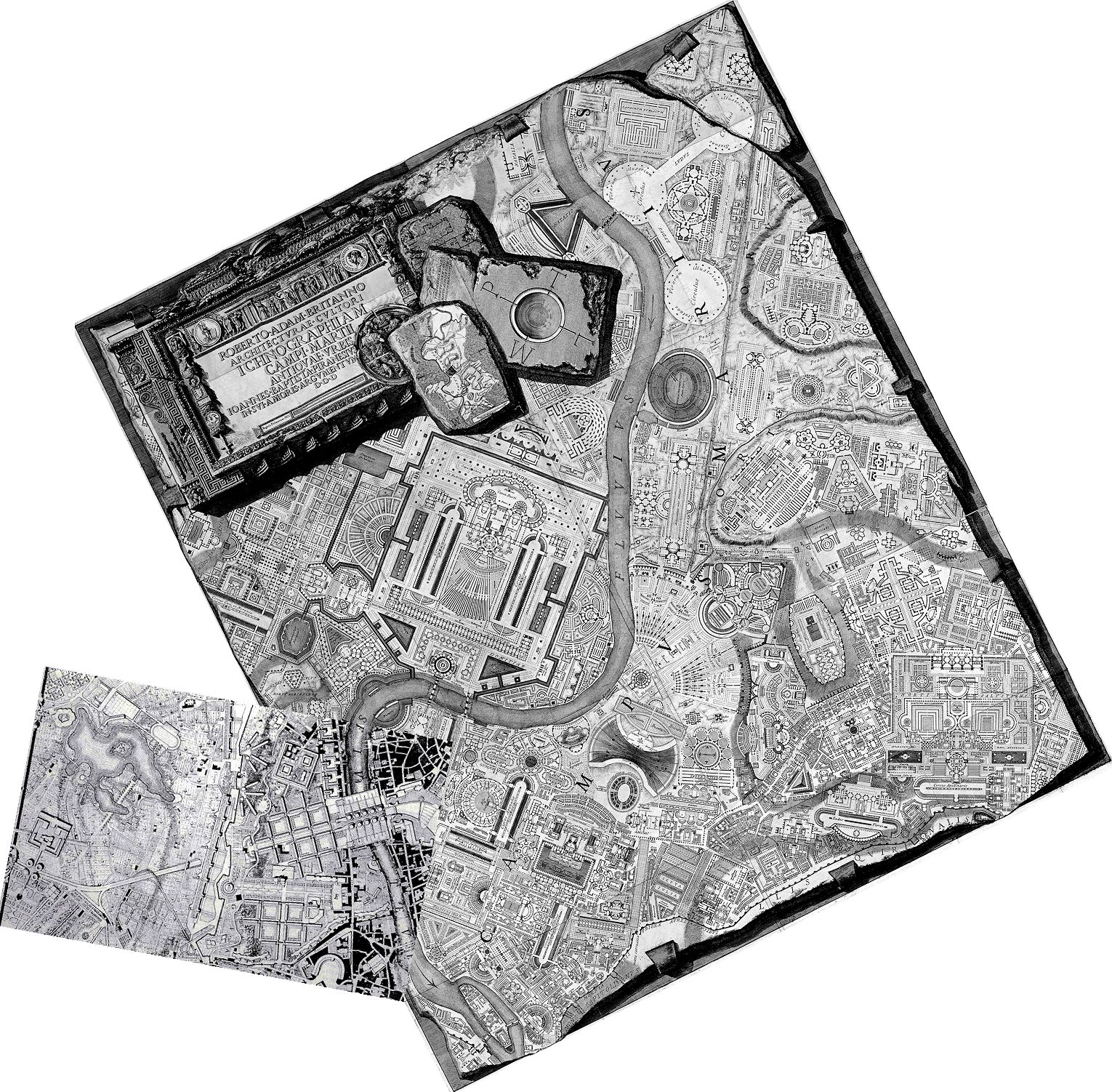James Stirling + Partner
Roma Interrotta: Sector IV
1978
Megalomania is the privilege of a chosen few. Piranesi who made his plan in 1761 was surely a megalomaniac frustrated architect (MFA), as also Boullee, Vanbrugh, Soane, Sant'Elia, Le Corbusier, etc., and it is within this distinguished company as an MFA architect that we make our proposal. The megalomaniac architect is most frustrated with regard to projects designed but not built, so the initial decision was to revise Nolli's plan incorporating all our unbuilt works. Soon we were trying to incorporate the entire oeuvre, and in order to sustain a momentum a rigorous method was necessary. Therefore the selection of projects, is limited to those appropriate to aspects of context and association either to the circumstances of 1748, or to JS projects at the time they were designed--sometimes to both. ....
A selection had to be made of existing buildings and places essential to preserve/integrate/intensify, and this, along with contextual, associational, topographical, prototypical, typological, symbological, iconographical and archaeological considerations, has helped integrate JS projects.
This 'contextual - associational' way of planning is somewhat akin to the historic process (albeit timeless) by which the creation of built form is directly influenced by the visual setting and is a confirmation and a complement to that which exists. This process may be similar to that of 'Collage City' (and the teaching of Colin Rowe), and the working method of a few architects (e.g.: O M Ungers), and stands in comparison to the irrationality of most post-war planning--supposedly 'rational', but frequently achieving a reversal of natural priorities.
James Stirling, "Nolli Sector IV - James Stirling," Architectural Design (vol. 49, no. 3-4, 1979).
It is obvious that Stirling cared deeply for his unbuilt works, and he was no doubt well aware of the unfortunate dormancy of architectural designs destined to exist only as drawings. It is quite natural to ponder a "what if" world when looking at the plans and elevations of buildings that were never built. Similar to Michel Foucault's "archeological" methodology, which penetrates into the past seeking thoughts that are no more but perhaps once were, Stirling unearthed a "virtual city/museum" of his own architecture within the context of eighteenth-century Rome. The scheme is like a temporal inversion of Piranesi's Ichnographia of the Campo Marzio where, instead of a past Rome that never was, the plan presents a future Rome that will never be.
Stephen Lauf, Precedent XII (Quondam: seeking precedents... ...finding inspiration exhibit, 1997.03.20).
| |
Giovanni Battista Piranesi
Ichnographia Campus Martius
1762
What portion of the actual qualities of an 'architect', in the entire sense of the word, that is to say in the sense of a creator of ideal forms which have practical ends and the imagination of art, what portion of these characteristics are to be found in the figure and personality of G. B. Piranesi? Engraver, painter-engraver, architectural designer, scholar of Roman construction, in his own way an essayist and archeologist, scenographer, did he also strive for an active, militant role in architecture? In short, did he aspire to build as a participant in the architectural movements of his time, for clients who could furnish him themes and commissions equal to his high aspirations and inspirations? Or must his potent charge of architectural knowledge, of architectural dreams and visions, abounding in the immense production of his designs, engravings, and writing, be considered an immense potential which never found favorable conditions for its proper realization? And did he satisfy himself solely through his visions, his evocations, the world or universe which he discovered in his fascinating soul? Through that world which at that time was being revealed in a new light? Was he but the narrator of a poem about ancient history? These questions may seem superfluous, given the complexity of the Piranesian works, all directed to the study and representation of the architectural monuments of Rome, for which the designation of 'architect', beyond the of 'engraver', is implicit.
Vincenzo Fasolo
Not only is practically everything in Piranesi's immense oeuvre "virtual," but the degrees to which he both created "virtual place" and utilized "virtual" representations suggests the concept of virtuality pervaded his whole methodology as well. As a consummate engraver, Piranesi practiced "virtual architecture" designing "magnificent" buildings and an extraordinary city, filled volumes with "virtual archeology," and manifested "virtual prisons" that torture perception.
Viewed as a whole, Piranesi's creative output is nothing less than an enormous museum of architecture in the virtual realm.
Stephen Lauf, Precedent IV (Quondam: seeking precedents... ...finding inspiration exhibit, 1997.03.20).
|
